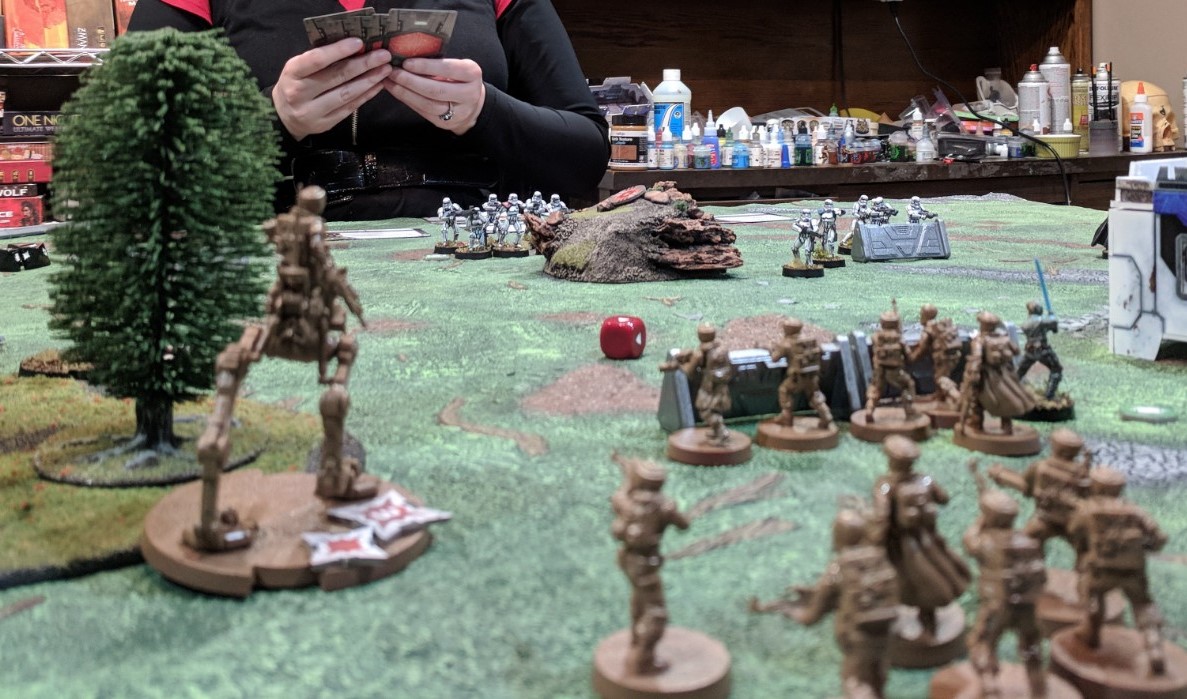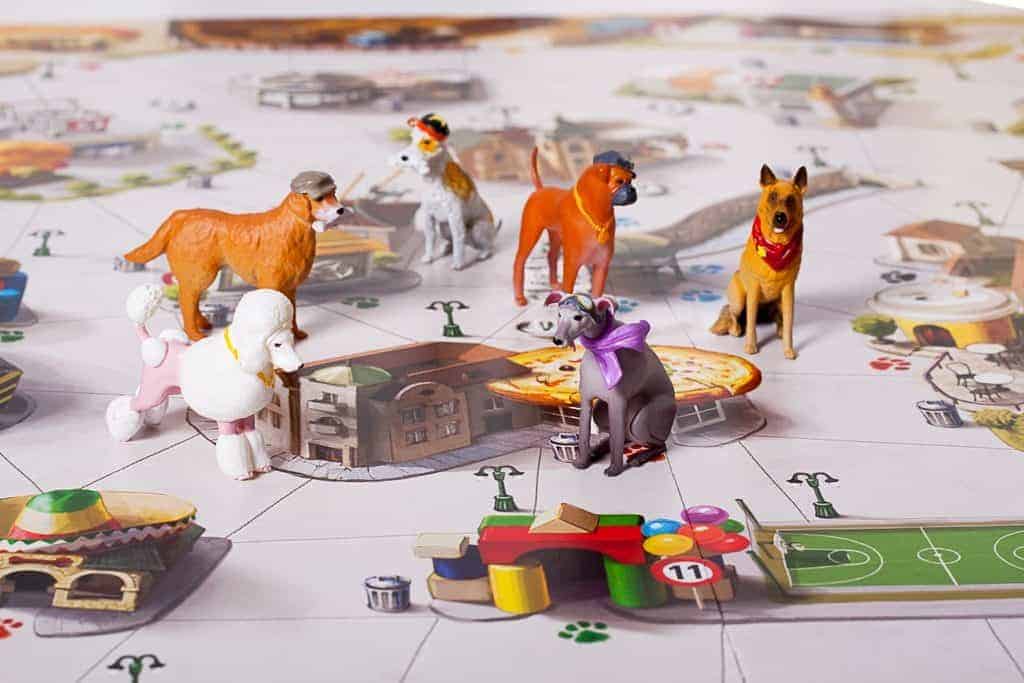Eric: Star Wars has always had a strange magic for me, a modern mythological mojo which transcends its contrived plots and sometimes stilted dialog.
I first felt the tingle of that power when I was seven years old. It was an open house at a local technical school. Back in a corner, away from the admittedly-modest crowds, was a little display for a “flat screen” television, cutting edge technology of that long, long time ago. The exhibit had just started, and as I walked up, two droids were surveying the blasted landscape of Tatooine. Perched on a ledge, I sat for the next six hours and watched the entire trilogy, lost in a galaxy far, far away.
That makes Star Wars: Legion, the new miniatures game from Fantasy Flight, hard to review. It tempts me to be too generous – just putting a lightsaber in someone’s hand provokes the ghost of a chill. At the same time, it makes me worry I will set the bar too high. To have expectations no collection of cardboard and plastic could ever meet. I say this to acknowledge that I come to this game as the farthest thing from a blank slate. I am a fanboy, with all the enthusiasm and critical nitpicking that entails.
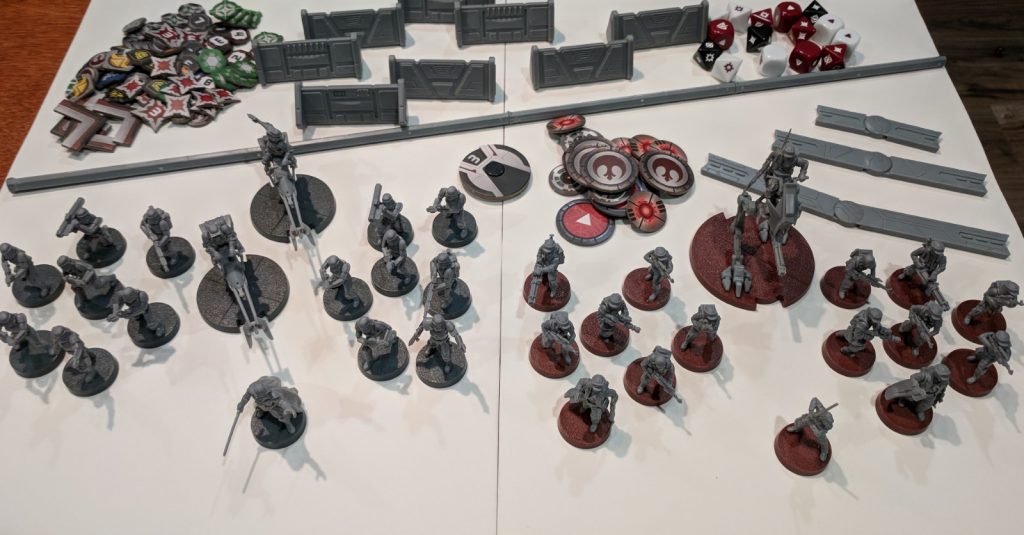
As I opened the box and surveyed Fantasy Flight’s usual spread of goodies, I felt that familiar tingle. At least the miniatures themselves were exciting. I immediately started assembling little stormtroopers and speeder bikes. “Assemble” is the right word, too. This is a true miniatures game, which means superglue and filing down mold lines. While the troopers are relatively simple, the larger models take a bit of work. This is not helped by the less-than-clear instructions. I’ve built hundreds of miniatures in my life and was still puzzled by one or two bits. I can only imagine how someone new to the hobby might feel.
Once built, the figures look great. They’re not fancy – Star Wars has a simpler aesthetic than the skull-bedecked ornamentation of Warhammer or the weird steampunk stylings of Malifaux – but they are higher quality than even Fantasy Flight’s usual offerings. They also paint up nicely, as I discovered over the next five hours, neglecting things like talking to my wife and sleeping in order to complete my first squad. Finally, after more frenetic but quite enjoyable painting, I got the game to the table.
This was the moment of truth – would the magic this game held as a physical artifact translate into its gameplay?
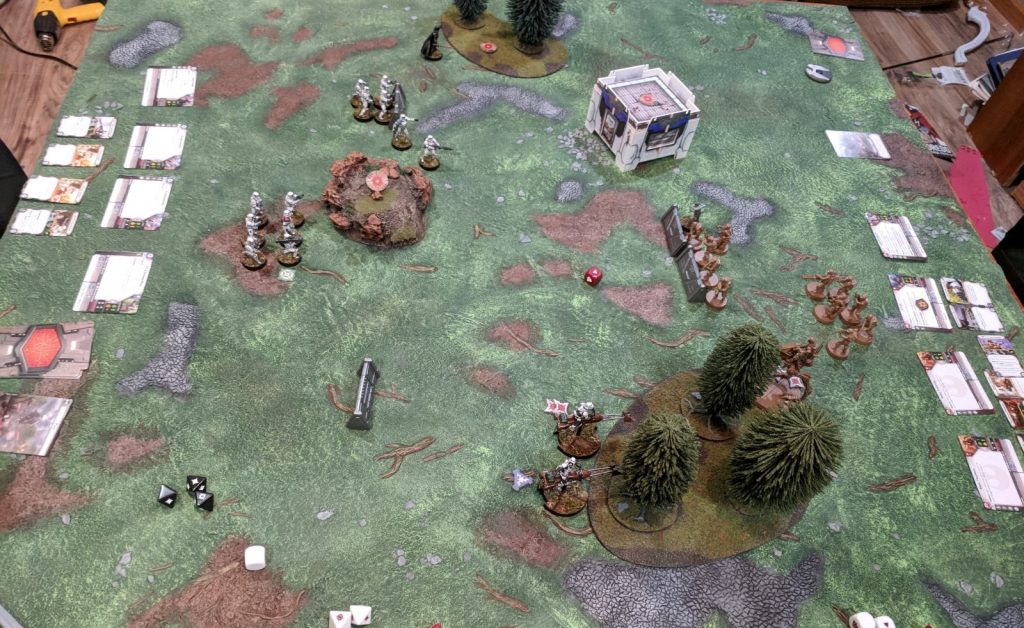
First, I should note that this is very much a Fantasy Flight game. If you’ve played X-Wing or Battlelore, much will be familiar. It uses special dice, of which there are far too few in the starting box. It has measurement widgets that fit into bases and a range band ruler. Then there are the cards – lots of cards. Everything is shiny and proprietary and exactly on brand.
One of the trademarks of those other games is their use of uncertainty. Take X-Wing, where both players simultaneously select their ships’ movement in secret. There’s some of this here. It hides in the system of orders which is Legion’s backbone. At the beginning of a turn each player chooses a command card. This card is both a bid on whether you will activate first and the number of units you can give orders. More on that in just a moment.
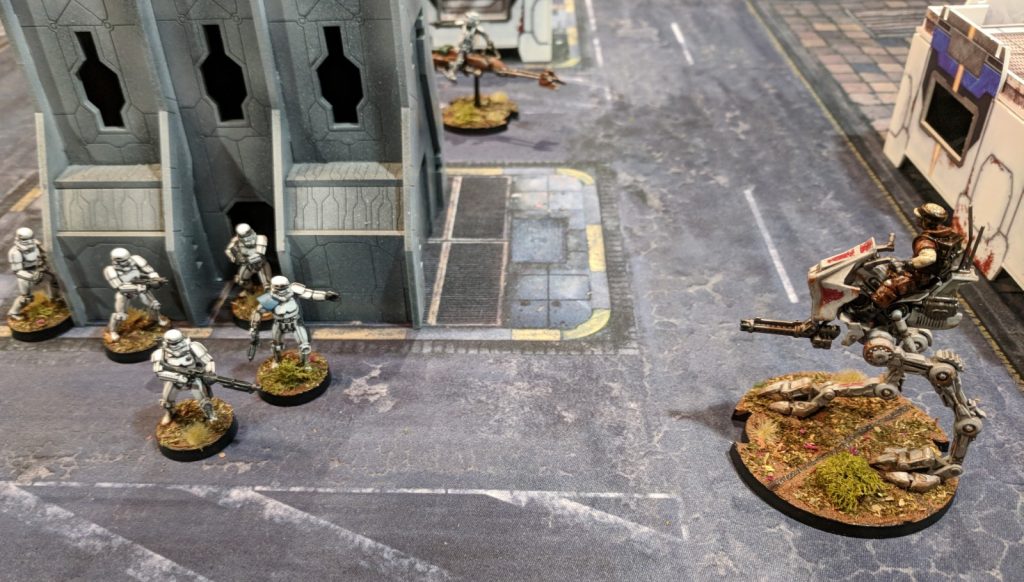
Legion uses alternating activations, meaning that you use one unit and then your opponent responds with one of theirs. In the case of units you gave orders with your command cards, you may activate them freely. For other units you have to go fishing in a bag for order tokens.
These tokens designate types of units rather than individuals, so there is some flexibility, but you won’t always get the one you want. In practice this means that each player must prioritize. The last thing you want is to desperately need to activate a unit whose order token is at the bottom of the bag.
The closest analogy to this system for many is going to be Shut Up & Sit Down’s much-loved Memoir ’44. While (unlike in Memoir) every unit can activate in Legion each turn, in both games the command structure means there is uncertainty about what will happen on the battlefield. It forces interesting choices, which is wonderful. It also makes things a bit chaotic, which some may dislike but I find perfect for the setting. Battles in Star Wars (and in real life) are less precise plans than constant adaptation, and Legion imparts that feeling of fighting by the seat of your pants. I can just imagine Han swearing under his breath as the Imperial forces close in.
The order structure aside, the core systems are pretty standard wargaming fare. Take two actions like move, attack, aim or recover. Roll dice to attack; have your opponent roll dice to defend. Where Legion shines is in the details.
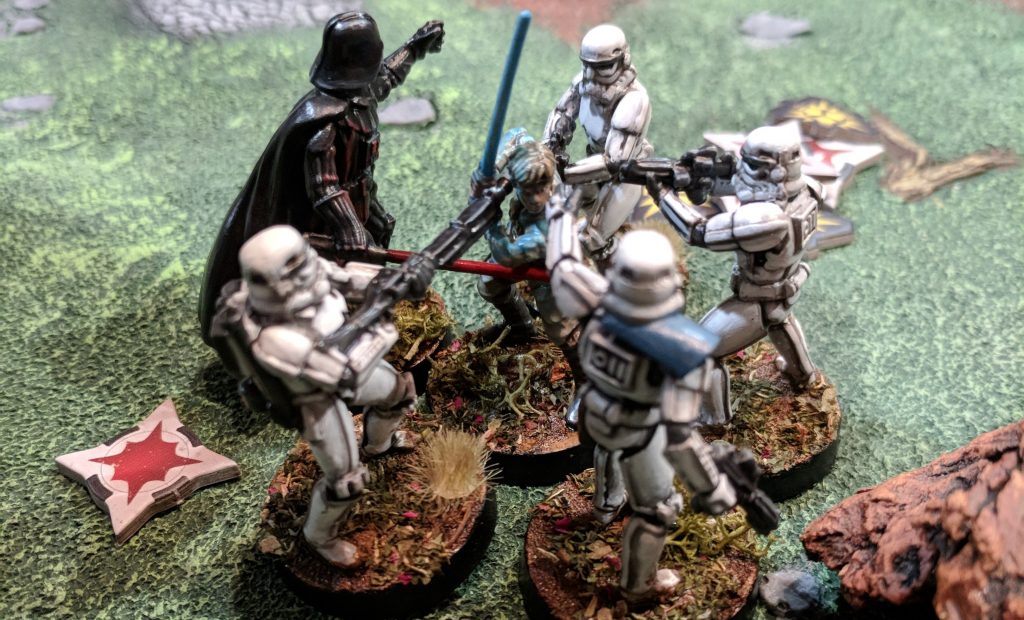
Take unit movement. Rather than individually measuring for each model, squads of infantry have a leader. Most measurements are made from this leader, planning out his actions and placing the other squadmates within a certain distance. While perhaps not perfectly realistic, it’s brilliant in play. I have an army in another miniatures game that takes twenty minutes to simply measure for and move each model. Every! Turn! Here, that would take a fifth of the time.
Tabletop grognards in love with tactical geometry in their games need not fear – positioning still matters and can result in some clever play. However, these rules make operating large groups of infantry feel easy when many games turn it into a chore.
Another example of these slick rules is morale. As you get shot at you accumulate “suppression tokens,” basically the cardboard equivalent of people screaming “Oh God, oh God, we’re all going to die!” As these tokens build up your troops might lose actions or even start to flee. To clear them away takes trusting in random chance or an action of its own, creating another interesting decision point. Cover, too, is a breeze. Legion uses true line of sight, which is sometimes contentious, but abandons the “percent of the model obscured” discussions in games like Infinity. Simply look from your unit leader and count how many enemy models are blocked; if it’s the majority of the unit, it’s in cover.
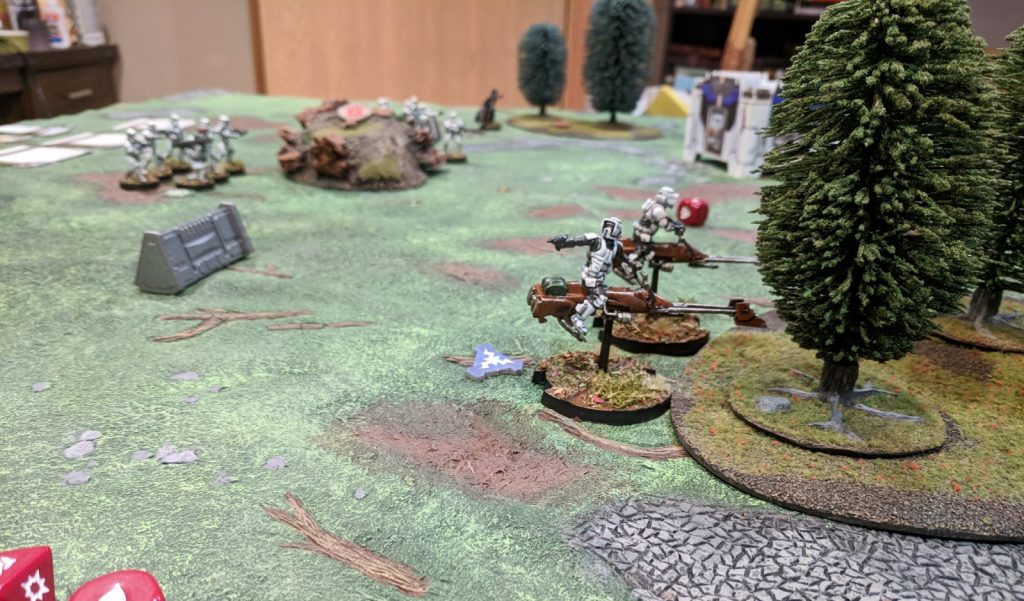
I can’t overstate how wonderful these systems and others felt in play. It’s effortless. A resistance you didn’t even realize was slowing you down suddenly disappears, like that moment you get out of the pool. Legion is not a simple game – each unit is a card full of text, with more cards full of more text attached to them. But everything about it is smooth. Indeed, it’s a testament to Legion’s ease of play that several non-miniatures gamers tried it out with me and almost instantly picked it up.
Of course, no system is perfect. I still found some of the fiddly idiosyncrasies that creep into all miniatures games. For instance, it often makes sense to arrange squads so that the normal troopers are behind barricades while the unit leader and heavy weapons are standing out in the open, which I understand is not usually advisable in live fire scenarios. The use of movement templates can also get a bit frustrating. While I appreciate why they exist, using solid 2d shapes with a single hinge on a 3d surface is often harder, not easier, than a traditional tape measure. That said, those are quibbles in a game full of potential to become something great.
However, we need to step back for a minute and talk about that word – “potential.” From everything I’ve just said, you might assume I recommend the game unreservedly. While I do love Legion, though, that love comes with a few qualifications.
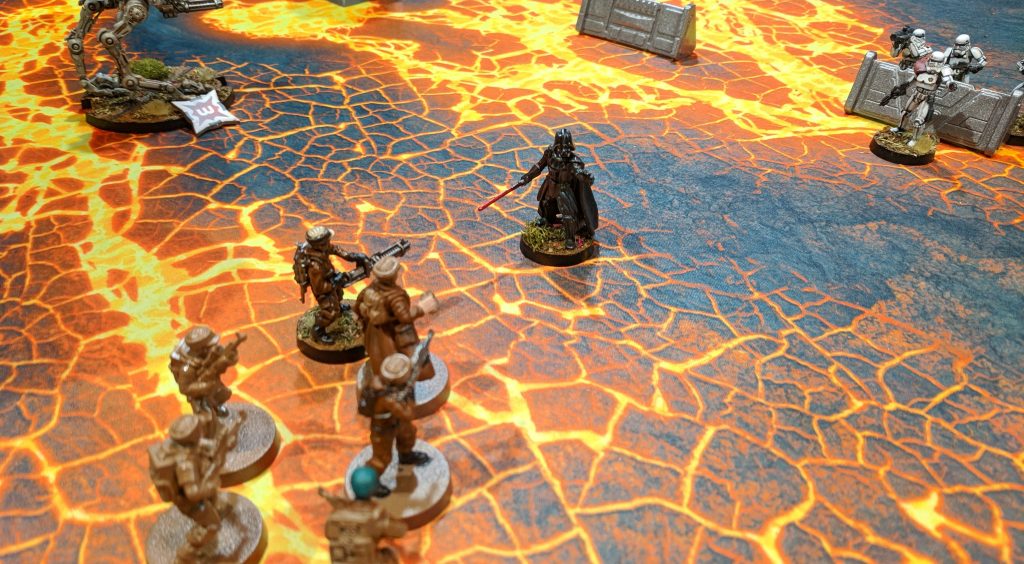
Let me try to zoom in on what makes miniatures games different than normal board games. Partially, it’s about investment. To play a miniatures game as it is meant to be enjoyed requires lots of money, and Legion is no different. The core box is affordable, but it only provides half of the army size FFG recommends. To play the game as intended now would require two boxes or a number of the expansions launching alongside the starter.
Even more than this investment of money, there is an investment of time. Assembling and painting figures, building terrain – I spent a good 15 hours with my paintbrush and still haven’t completed the core box. Legion expects this investment of its players. That’s fine if that’s what you’re looking for, but this is my big caveat: without that investment I don’t think Legion is that great a game.
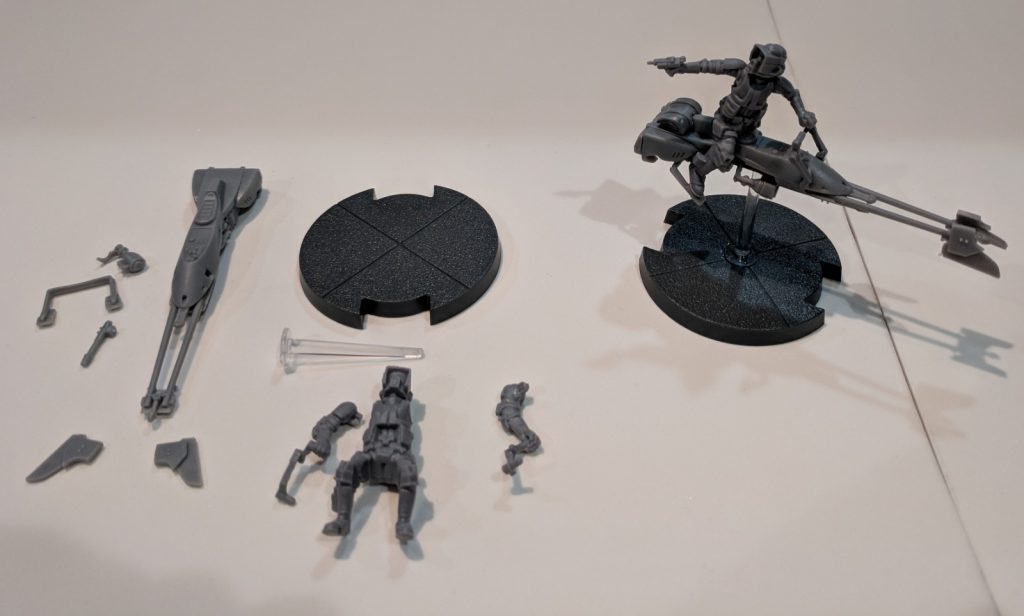
Unlike X-Wing, where just the base box felt like an exciting dogfight, many of Legion’s most interesting features don’t really work at the size included in the beginner box. This is especially true of the command system. It makes sense with games of 7-10 units, which is the range I imagine most armies will field. With only the 4 units in the starter box most of its uncertainty is removed. Likewise, thanks to the limited size of armies, a little bad luck in the core set can feel crippling. As in most dice-based games, you need the law of large numbers to smooth out the probability curve. Losing a unit to a spike in the dice matters much more when it is 25% of your army than when it is only 10%. Certain models in the core set – especially the commanders – can also become nigh-indestructible, reducing the outcome of games to luck-fests. All of these problems disappear when playing at the game’s recommended size – I proxied a bit to test out that level and it is a much more even experience. But if you are treating this as a single-box game, I’d honestly say you should give it a pass.
That said, if you are willing to make that investment – if you want a sprawling miniatures game that you play over and over, experimenting with lists, collecting models and trying different tactics – Legion has the potential to be something special. I still say potential because those games are made or broken by the quality of their ongoing support. There are already numerous expansions planned, ranging from other basic troops to iconic units like AT-STs or Princess Leia, but I haven’t played with them yet. In a year or two, if that support continues, Legion could be a dominant force in the wargaming landscape, potentially even dethroning Warhammer 40,000. That, however, will take some time to see.
All of which sounds more negative than I intend. So here’s what I want to make clear – for all those cautions, the magic is still definitely here. For me, Legion felt like those first few scenes of A New Hope I watched all those years ago. It didn’t fully make sense yet. C-3PO’s fretting and Luke’s whining in themselves do not a classic make. But as my stormtroopers advanced across the field to kill the rebel scum, I couldn’t wipe the grin off my face. The force is strong with this one. It will just take a little time to tell whether it can truly become a Jedi.

